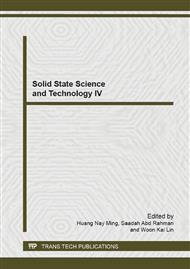[1]
S. Joseph, M. S. Sreekala, Z. Oommen, P. Koshy and S. Thomas: A comparison of the mechanical properties of phenol formaldehyde composites reinforced with banana fibres and glass fibres. Compos Sci Technology 62 (2002), pp.1857-1868.
DOI: 10.1016/s0266-3538(02)00098-2
Google Scholar
[2]
K. Joseph, S. Varghese, G. Kalaprasad, S. Thomas, L. Prasannkumari, P. Koshy and C. Pavithran: Influence of interfacial adhesion on the mechanical properties and fracture behaviour of short sisal fibre reinforced polymer composites. Eur Polym J 32 (1996).
DOI: 10.1016/s0014-3057(96)00051-1
Google Scholar
[3]
L. Kun, F. Shiyu, Z. Huaiyu, Z. Yao and A.L. Lucian: Analysis of the chemical composition and morphological structure of banana pseudo-stem. Bioresources. com 5(2), pp.576-585.
Google Scholar
[4]
L.Y. Mwaikambo and M.P. Ansell: The effect of chemical treatment on the properties of hemp, sisal, jute and kapok for composite reinforcement. Die Ang Makro Chem 272, (1999), pp.108-116.
DOI: 10.1002/(sici)1522-9505(19991201)272:1<108::aid-apmc108>3.0.co;2-9
Google Scholar
[5]
S. Elanthikkal, U. Gopalakrishnapanicker, S. Varghese and J.T. Guthrie: Cellulose microfibres produced from banana plant wastes: Isolation and characterization. Carbohydrate Polymer 80, (2010), pp.852-859.
DOI: 10.1016/j.carbpol.2009.12.043
Google Scholar
[6]
W. Leilei, H. Guangting, Z. Yuanming: Comparative study of composition, structure and properties of Apocynumvenetum fibers under different pretreatments. Carbohydrate Polymer 69, (2007), pp.391-397.
DOI: 10.1016/j.carbpol.2006.12.028
Google Scholar
[7]
Z. Wei, L. Mei, L. Canhui: Morphological and structural development of hardwood cellulose during mechanochemical pretreatment in solid state through pan-milling. Cellulose 14, (2007), 447-456.
DOI: 10.1007/s10570-007-9135-y
Google Scholar
[8]
S. Elanthikkal, U. Gopalakrishnapanicker, S. Varghese and J.T. Guthrie: Cellulose microfibres produced from banana plant wastes: Isolation and characterization. Carbohydrate Polymer 80, (2010), pp.852-859.
DOI: 10.1016/j.carbpol.2009.12.043
Google Scholar
[9]
B. M. Cherian, L.A. Pothan, T.N. Chung, G. Mennig, M. Kottaisamy and S. Thomas: A novel method for the synthesis of cellulose nanofibril whiskers from banana fibers and characterization. Journal of Agriculture and Food Chemistry 56, (2008).
DOI: 10.1021/jf8003674
Google Scholar


